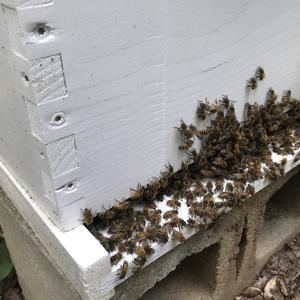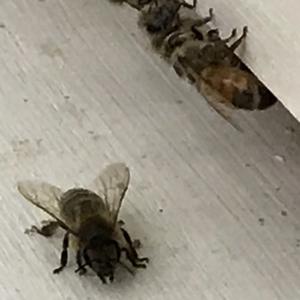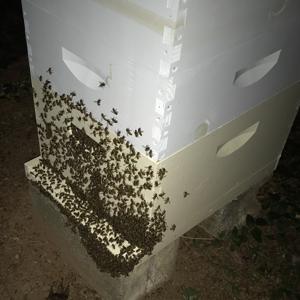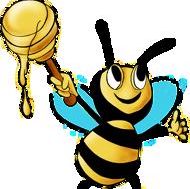There are more than 20,000 species of bees in the world, but only 7 – 11 species of honey bees (some sources put that number officially at 7) with 44 subspecies. The most common is the Western honey bee (Apis mellifera). It originated in eastern Africa and spread across that continent, Asia and Europe. No honey bee species is natural to North America. British colonists brought hives of the Western honey bee to the Jamestown settlement in the early 1600s. As honey bees tend to do, these original hives sent out swarms that spread west in advance of the pioneers.

There are many subspecies or races of Western honey bees. The most common in the U.S. are the Italian, Carniolan, Caucasian and Russian. Our bees are mainly a hybrid of Italian and Carniolan. Many of these races have been bred for certain characteristics, like honey production, gentle temperament, disease resistance, brood production, etc.
During the spring and summer the population of a honey bee colony will be around 50,000 bees. In fall the queen begins laying fewer eggs so that the population will decrease during the winter. Honey bees do not hibernate, but get through winter by eating honey they stored in the hive and clustering around the queen and what brood there may be to generate heat. They keep the temperature in that cluster at around 95° F.
Types Of Bees

There are three types of bees in each hive; the queen, workers and drones. Drones are the only male honey bees and they have only one job, mate with a queen. They live up to four months. When they’re not out on a mating flight drones lounge around the hive resting or eating honey or begging for honey from worker bees. As winter approaches worker bees will force drones out of the hive, since they are too much of a drain on the resources of the hive during the winter.
Worker bees are the smallest and most numerous of the honey bees. They do all of the work in the hive and their jobs change as they age. They tend to brood, attend the queen, clean the hive, make wax cells to be used by the queen to lay eggs and to store honey. They guard the hive and then finally they become foragers, flying from the colony to collect pollen and nectar to make honey. The lifespan of a worker bee depends on when she is born. Those born in spring and summer will live up to six weeks. Workers born in late summer or fall may live up to six months, as they need to survive the long winter months.

There is one queen honey bee per hive. She is larger the other bees and has one job; to lay eggs. When a new queen hatches she will go on a mating flight and mate with a number of drones, storing their sperm for the rest of her life. A queen can lay up to 1,500 eggs per day. If she fertilizes an egg it will become a worker. Unfertilized eggs develop into drones. A queen can live for up to five years.
Honey bees have two means of reproducing. The first is when the queen bee mates and then lays eggs to produce more bees. But the colony itself will occasionally reproduce by swarming. This is when the queen leaves the hive taking half to three-quarters of the workers with her to find a new home. The bees left behind will raise a new queen and maintain the colony. A honey bee becomes a queen when it is fed royal jelly exclusively as a larva. All larvae are fed royal jelly for the first day or two of their lives, but then they are fed a mixture of nectar and pollen called bee bread.
Honey Bee Products
Honey is the most obvious product of the honey bee. People have been harvesting honey from wild honey bees and domesticating honey bees for honey for thousands of years. See more facts about honey here.
Honey bees produce a number of other products that humans have found use for. The wax that honey bees create to form their hives and house brood and honey has many uses. Beeswax is used in making candles, lip balm and in many cosmetic products, including beard and mustache wax.

Propolis, or bee glue, is a sticky substance that honey bees make from the sap and resin of plants and trees. They use it to seal small open spaces in the hive. They also use to prevent putrefaction in the hive. If a mouse or lizard or other small animal gets inside the hive and dies the honey bees may not be able to carry it out of the hive. In that case they will cover the carcass in propolis to keep it from spreading disease and odor.
Scientists believe propolis may have antibacterial properties and may fight viruses, fungi and have anti-inflammatory properties. It is currently used in some medicines and tinctures as well as cosmetic products.
Bee venom, the poison that makes a bee sting painful, has some medicinal uses. It is used to treat rheumatoid arthritis, nerve pain, MS, swollen tendons and muscular conditions.
